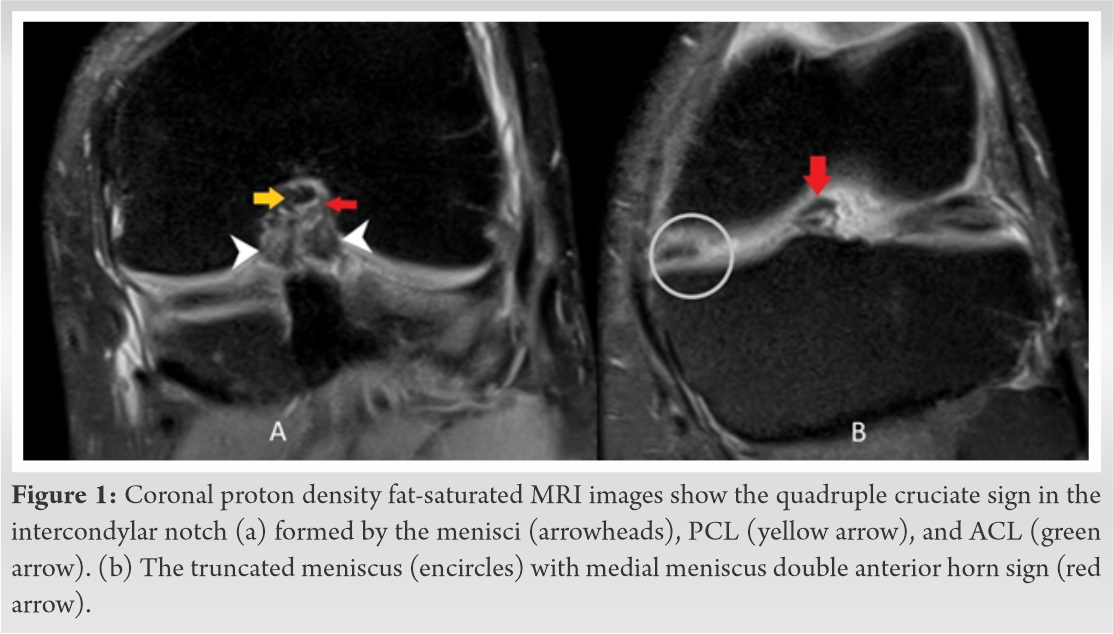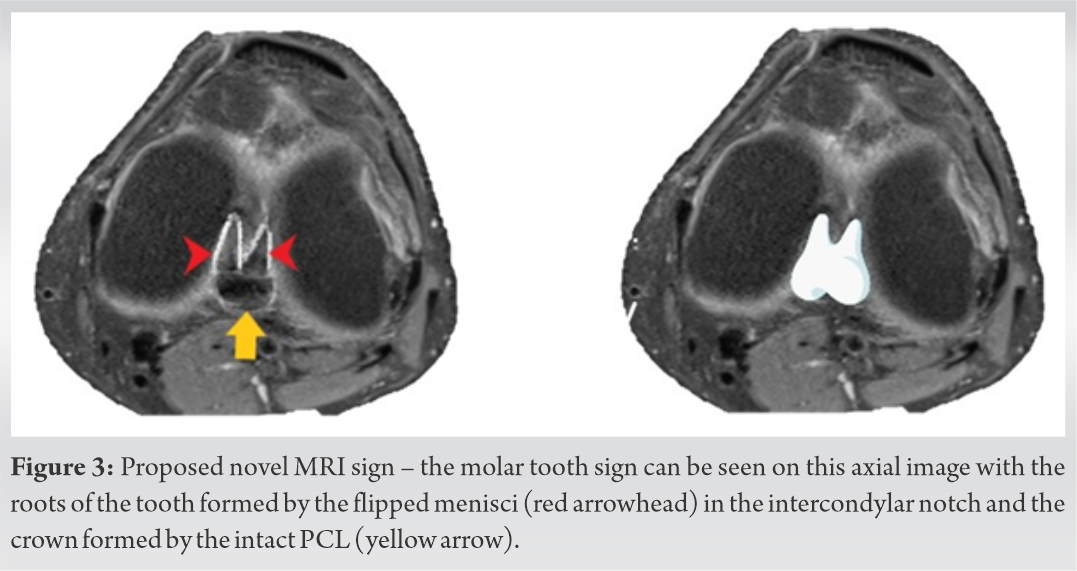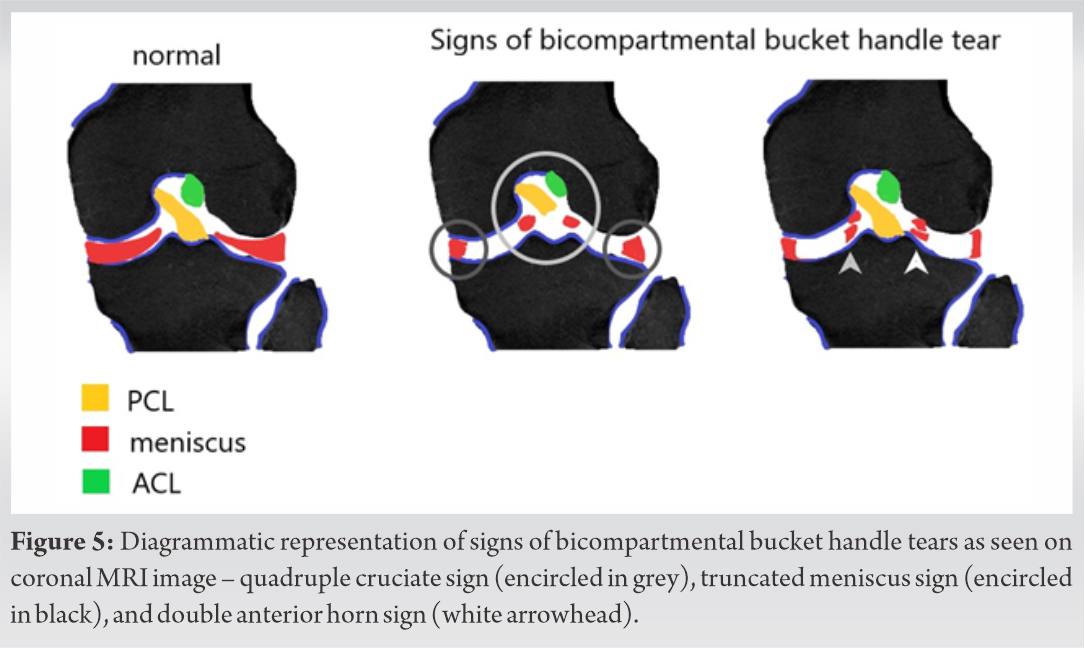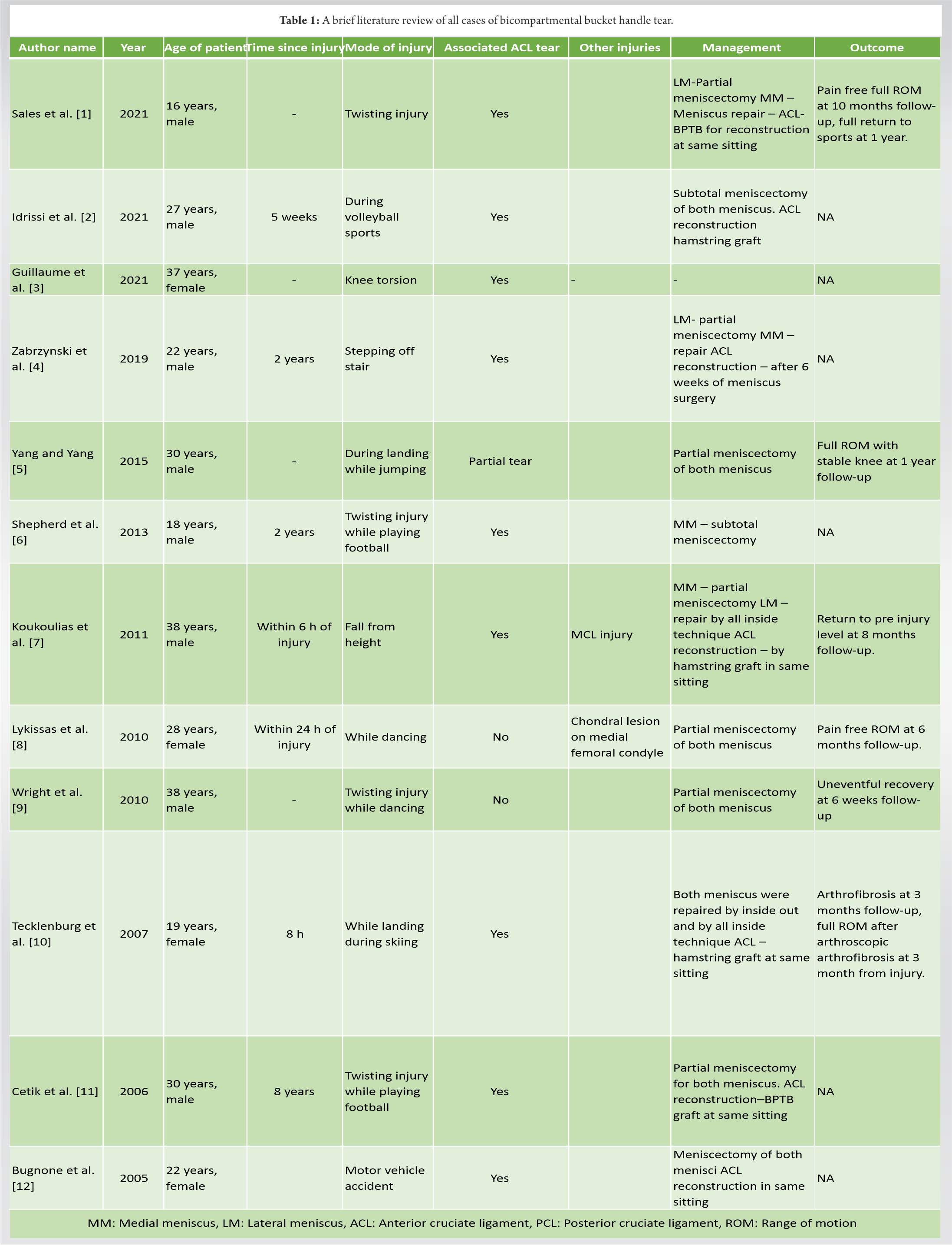A bucket handle tear is rare, with simultaneous bucket handle tears of both the medial and lateral menisci rarer, an unmissable entity for accurate preoperative diagnosis for timely management.
Dr. Aakanksha Agarwal, Department of Radiology, St. Paul’s Hospital, Vancouver, British Columbia, Canada. E-mail: a.agarwal.1992@gmail.com
Introduction: Simultaneous bucket handle tear of both lateral and medial menisci is a rarely encountered entity. MR imaging helps in pre-operative diagnosis for optimal operative planning. However, as this condition is not seen in routine practice, awareness of various imaging signs is essential to identify this condition. Few signs on coronal and sagittal images have been described in the literature but none so far on axial images.
Case Presentation:We propose a novel “molar tooth sign” in the knee on axial MRI images, in which we identified in the case of a young male with recurrent knee locking after a fall from height.
Conclusion: Different modes of injury can lead to different patterns of meniscal and ligament tears. Having an allied sign which is, furthermore, easy to imagine will help, not only the radiologists but also the surgeons, to identify rare types of meniscal tears similar to the index case.
Keywords:Bicompartmental bucket handle tear, molar tooth, arthroscopy of knee, meniscal repair.
“Molar tooth” sign has been talked about in the radiological literature for pathologies in the brain and abdomen. Because the eyes do not see what the brain does not know, it is essential not only to be aware of rare entities such as simultaneous bicompartmental bucket handle tears but also be able to diagnose them preoperatively for optimal surgical planning. Signs help the human brain to use the power of imagination for identifying conditions that they might not have yet encountered. We present a rare case and point out an imaginable sign to identify the condition on planning magnetic resonance imaging (MRI) and also validate our finding on arthroscopy.
A 39-year-old male presented with complaints of recurrent knee locking and pain in the left knee following a fall from a height of 7 feet, 4 years back, presented to the orthopedic clinic for management. On examination, there were evident quadriceps wasting of 3 cm with a positive Lachman test, anterior drawer test, pivot shift test, McMurray test, and Apley’s grinding test. There was no laxity in the coronal plane and the dial test was negative. A clinical diagnosis of anterior cruciate ligament (ACL) tear with meniscal tear was made and the patient was advised radiological examinations. Kellgren-Lawrence Grade II osteoarthritis was noted on a plain radiograph of the knee which did not reveal any fracture. His Lysholm knee score was 62/100.
MRI was performed on a 3T scanner using a dedicated knee coil. Proton density fat-saturated images were acquired in all planes in addition to a T1-weighted image and gradient echo image. The MRI was diagnostic of a complete chronic ACL tear, medial, and lateral meniscal tears with bucket handle components giving rise to the “triple posterior cruciate ligament (PCL)” sign, double anterior horn sign, and an osteochondral defect in the medial femoral condyle (Fig. 1, 2).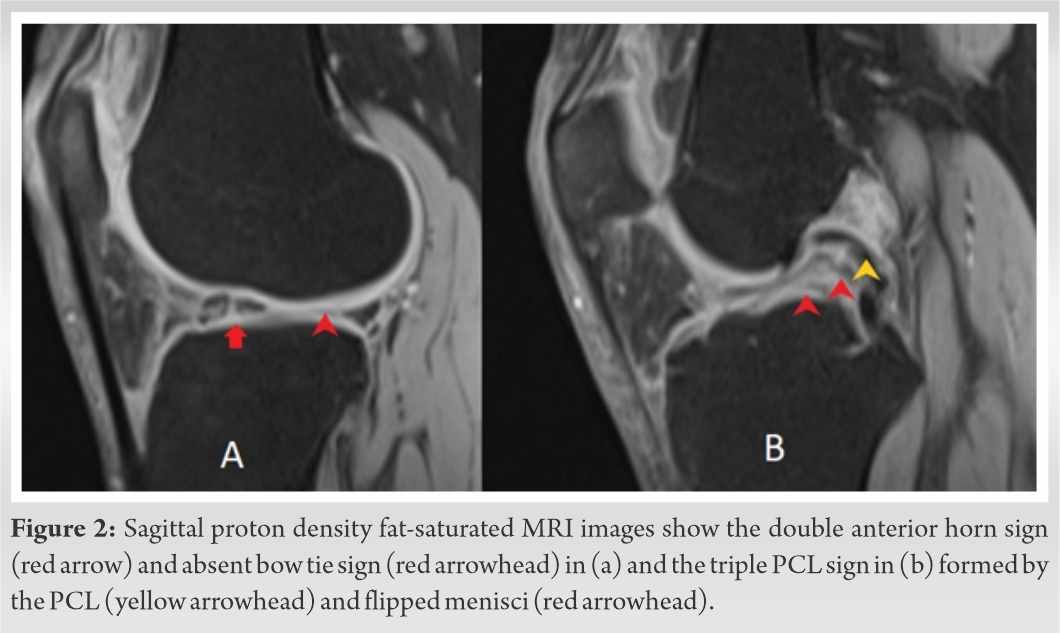
Based on the clinical and radiological findings, the patient was advised arthroscopic ACL reconstruction with meniscal repair/menisectomy. Intraoperatively, diagnostic arthroscopy confirmed a complete ACL tear with an avulsed femoral attachment, bucket handle component arising from meniscal tears of both medial and lateral menisci, and osteochondral defect in medial femoral condyle and an intact PCL. Arthroscopic single bundle ACL reconstruction was done using a five-strand semitendinosus and gracilis autograft. The bucket handle component of medial meniscus (MM) had a complex morphology due to which subtotal menisectomy was performed. For the lateral meniscus, the bucket handle component was reduced and repaired using two sharp-shooters by inside-out method (Fig. 4).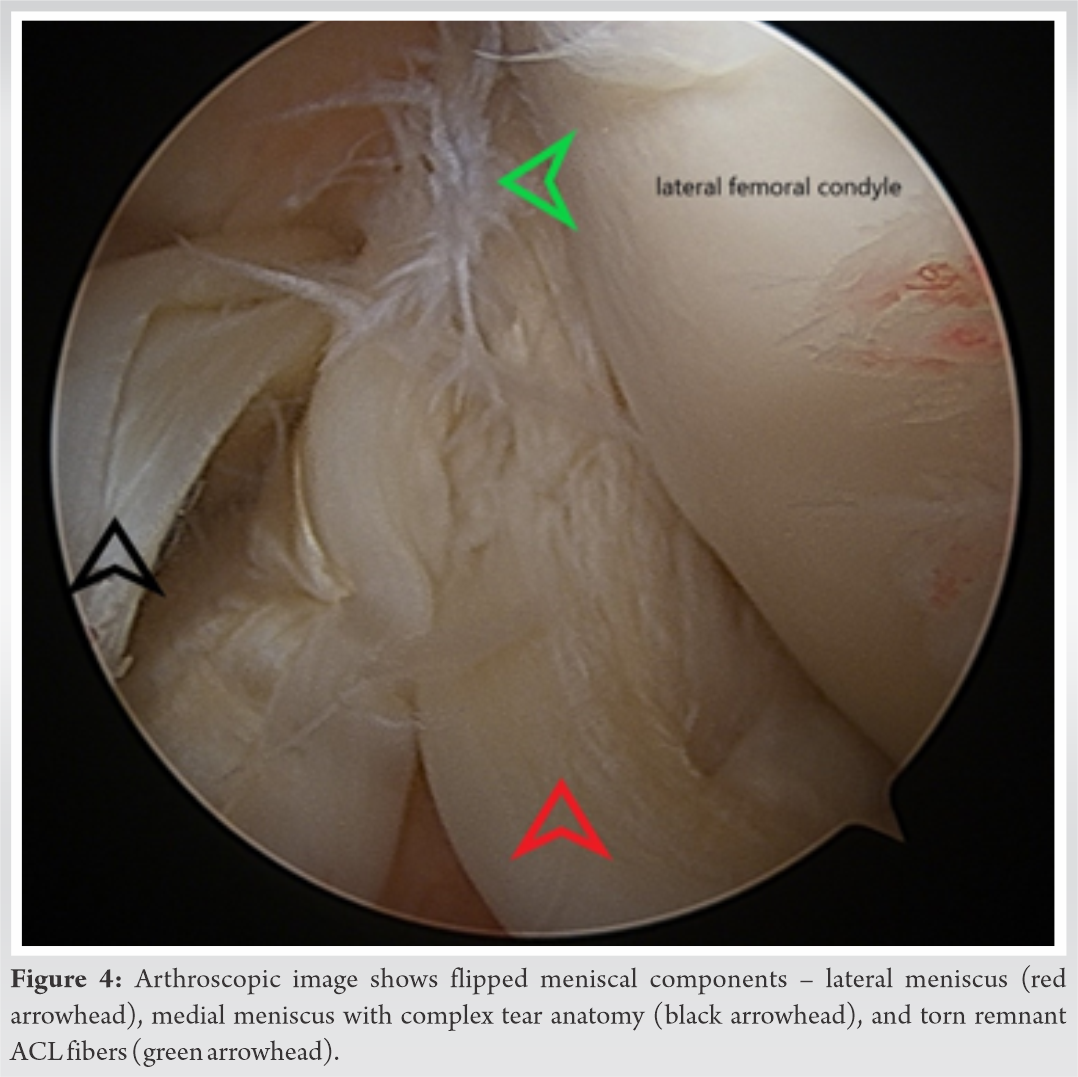
Simultaneous occurrence of bucket handle tears of both menisci of the same knee is a rare occurrence with interesting and seldom viewed signs on MRI imaging. Few case reports of the same have been published in the literature (Table 1) which shows that a sudden complex twisting injury of the knee results in this condition [1, 2, 3, 4, 5, 6, 7, 8, 9, 10, 11, 12]. In our case, the patient fell from a height, probably twisting his knee with the torque tearing both menisci of his left knee. Most common associated injury is a tear of the ACL, same as our case. Koukoulias et al. [7] reported a case with an accompanying medial cruciate ligament tear, while Lykissas et al. [8] discussed a case with an associated chondral lesion of the medial femoral condyle with the latter resembling the finding in the index case. The youngest patient reported was a 16-year-old male reported by Sales et al. [1] and the oldest were aged 38 years Koukoulias et al. [7] and Wright et al. [9]. Our patient is 1 year older.
Radiological diagnosis in each case was performed by an MR examination which displayed novel and interesting signs – triple PCL sign, quadruple cruciate sign, double anterior horn sign, truncated meniscus sign, and absent bow-tie sign [1, 12]. With this case, we propose a new radiological sign on axial MRI images – the molar tooth sign which has not been previously described in the literature (Fig. 3, 5, 6).
The surgical intervention was performed 4 years following injury in the index case. In the literature, operative intervention has been done as early as within 8 h of injury [10] up to 8 years after injury [11]. Partial or subtotal menisectomy was performed in majority of the cases, while meniscal repair was reserved for those cases which on arthroscopy exhibited salvageable, reducible, and non-complex tear anatomy. In our case, the MM was excised, while the lateral was reduced and repaired. Simultaneous ACL reconstruction was done for the patient. Some authors such as Shepherd et al. [6] and Zabrzynski et al. [4] performed a two-step procedure addressing the meniscus pathology before reconstructing the concurrent torn ACL.
Bi-compartmental bucket handle tear of the meniscus is a rare entity precipitated by a sudden torque to the knee joint. Very few cases have been described in the literature. This article provides a brief summary of all similar cases described in the literature with their imaging diagnosis and operative management. Some signs have been described in the literature to aid diagnosis on MRI. We propose a novel “molar tooth sign” on axial MRI imaging which has not been described before to add to diagnostic confidence.
Rare conditions tend not to have a defined course of management. They are usually dictated by the treating physician’s preference and it is essential to be aware of possible rare occurrences before entering the surgical field. We suggest to look for a “molar tooth” in axial MRI images of complex meniscal tears with evidence of loss of meniscal volume to ensure to not miss bicompartmental bucket handle tears. The literature review lays out the various surgical approaches used in the past and provides a path for possible future choices. Because this condition is rare, the various signs described in the literature and the novel sign suggested by the authors will continue to be scrutinized and validated over time.
References
- 1.Sales E, Gupta S, Daines B, Baker A, Landgrabe M, Zeini IM, et al. Bicompartmental bucket handle meniscal tear with chronic ACL deficiency causing a rare triple PCL and triple cruciate sign: A case report. JBJS Case Connect 2021;11:e20.00694. [Google Scholar]
- 2.Idrissi M. Simultaneous “Bucket-Handle” tear of both menisci on the same knee. Sch J Med Case Rep 2021;9:243-5. [Google Scholar]
- 3.Guillaume S, Bodart A, Collart J. The triple posterior cruciate ligament sign in bicompartmental bucket handle meniscal tear. J Belg Soc Radiol 2021;105:28. [Google Scholar]
- 4.Zabrzynski J, Szwedowski D, Zabrzyńska A, Łapaj Ł. Bicompartmental locked bucket-handle tears of menisci concealing the concomitant anterior cruciate ligament injury for 2 years-a case report. J Med Sci 2019;87:225-8. [Google Scholar]
- 5.Min YL. Traumatic bucket-handle tears of both menisci with anterior cruciate ligament injury on the same knee-a case report. J Trauma Treat 2015;s2:16. [Google Scholar]
- 6.Shepherd J, Abdul-Jabar HB, Kumar A. Locked bucket handle tears of the medial and lateral menisci with associated chronic ACL deficiency. BMJ Mil Health 2012;158:335-7. [Google Scholar]
- 7.Koukoulias NE, Kyparlis D, Koumis P, Lola D, Papastergiou SG. Locked bucket-handle tears of both medial and lateral menisci with simultaneous anterior cruciate and medial collateral ligaments injury. BMJ Case Rep 2011;2011:bcr0320114046. [Google Scholar]
- 8.Lykissas MG, Mataliotakis GI, Paschos N, Panovrakos C, Beris AE, Papageorgiou CD. Simultaneous bicompartmental bucket-handle meniscal tears with intact anterior cruciate ligament: A case report. J Med Case Reports 2010;4:34. [Google Scholar]
- 9.Wright J, Tamura C, Findlay I, Daneshfar A. Simultaneous bicompartmental bucket handle meniscal tears with a clinically competent anterior cruciate ligament. J Orthop Surg 2010;5:68. [Google Scholar]
- 10.Tecklenburg K, Schoepf D, Hoser C, Fink C. Anterior cruciate ligament injury with simultaneous locked bucket-handle tears of both medial and lateral meniscus in a 19-year-old female professional ski racer: A case report. Knee Surg Sports Traumatol Arthrosc 2007;15:1125-9. [Google Scholar]
- 11.Cetik O, Cirpar M, Eksioglu F, Uslu M. Simultaneous bucket handle tear of both medial and lateral menisci of a knee with chronic anterior cruciate ligament deficiency. Knee Surg Sports Traumatol Arthrosc 2006;14:356-9. [Google Scholar]
- 12.Bugnone AN, Ramnath RR, Davis SB, Sedaros R. The quadruple cruciate sign of simultaneous bicompartmental medial and lateral bucket-handle meniscal tears. Skeletal Radiol 2005;34:740-4. [Google Scholar]


